Fish Couscous (Cous Cous)
Product included in the national list of traditional agri-food products (PAT)
PAT type: Gastronomy products
Production area: Western Sicily.
Historical curiosities
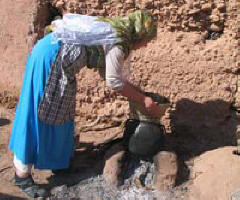
Couscous (but also couscus, couscous, cous cous, in Berber seksu, in Arabic kuskusu) is the traditional food of all of North Africa, consisting of semolina grains (coarsely ground durum wheat) steamed (with a diameter of one millimeter before cooking). The roots of the couscous are in the Maghreb, where the Berbers have always lived, or rather, as they prefer to be called, Amazighen - free men. ICouscous today is a dish that can be eaten throughout the Maghreb area - Algeria, Morocco, Tunisia - but also in Egypt, Israel and Palestine.
Usually couscous accompanies stewed meats and / or boiled vegetables (on the Mediterranean coast also stewed fish). It can be made spicy by accompanying it with harissa (mainly used in Tunisia).
In Sicily, in the Trapani area, the traditional ingredient of meat has been replaced with fish
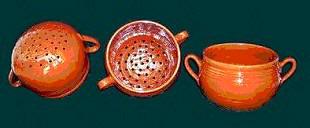
The term couscous indicates both the semolina and the complete dish. In the North African tradition, women used to gather in groups for several days to prepare a large quantity of couscous in grains. The expert hands of the women "rotated" the semolina to "cross it" with the help of a few drops of salted water. Once the semolina was mixed, the Arab women put it to cook in a pot with holes placed on top of another filled with boiling water. Removed from the heat after about twenty minutes, the couscous was worked again with water and salt, and put back to cook. This operation was repeated two or three times. Finally, the cooked couscous was spread out on mats, dried and placed in cloth sacks. In this way the couscous could be stored for several months.

| Traditional preparation of couscous |
The couscous preparation phase is called “incocciata”, it consists in the transformation of the semolina with the help of water into small round lumps a little bigger than the semolina that is available on the market. For the preparation a low and wide terracotta tureen is used, (the “mafaradda”) where the flour is poured in small quantities. The processed semolina is instead poured into a varnished terracotta container (the “lemmo”). Prepare a bowl of water and salt (5 grams of salt for every 100 cc of water).

Place a handful of semolina in the "mafaradda" and a spoonful of salted water next to it, then continue with 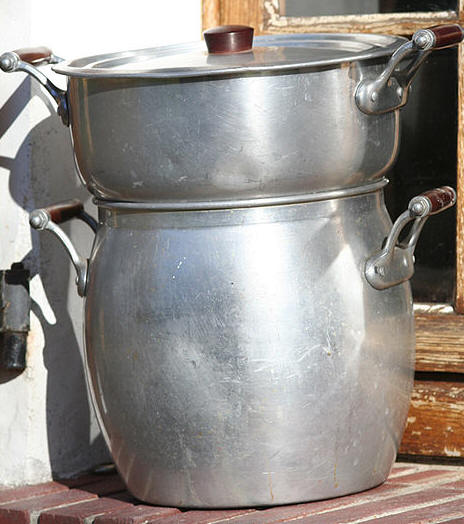 rotational movements of the fingers in order to make the semolina absorb the water and, at the same time, form grains that we will deposit in the "lemmo". Proceed until the semolina runs out. Add a drizzle of extra virgin olive oil to the “incocciata” semolina and, with the palm of your hands, rub it so that, in the end, all the grains are greased with oil and well shelled.
rotational movements of the fingers in order to make the semolina absorb the water and, at the same time, form grains that we will deposit in the "lemmo". Proceed until the semolina runs out. Add a drizzle of extra virgin olive oil to the “incocciata” semolina and, with the palm of your hands, rub it so that, in the end, all the grains are greased with oil and well shelled.
The dosage of the water and the crumb of the semolina are closely linked to the skill of the performer.
When finally all the semolina has been collected in very small lumps, the couscous will be sieved to remove any excess flour and spread on a towel to dry
The traditional North African method involves the use of a steamer called cushionsystem. (taseksut in Berber, kiska: yes in Arabic) The base is an elongated metal pot with a rounded shape in which vegetables and stewed meat are cooked. Above this base is placed the container with a perforated bottom in which the couscous is steamed, absorbing the flavors of the broth below. If the joint between the edge of the lower pan and the upper pan is not airtight, a damp cloth is often placed in order to prevent the steam from escaping from the sides. In some cases, a mixture prepared with a mixture of water and flour is used instead of the damp cloth. This is because the steam should come out only from the top of the cushions (steamer)
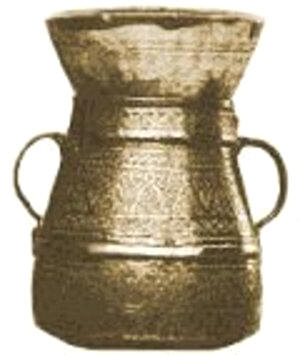
The “couscous” used in the Trapani area is generally composed of a kind of flat-bottomed painted terracotta colander, with its lid and a high-sided pot capable of housing the couscous bowl.
There are also other types of “couscous” called “French style” built in steel or aluminum where the “couscous” is directly embedded in the pot that will contain the cooking water. In general, in French cushions it is not necessary to "seal" the point of union between the lower and upper parts of the cushions.
On the market there is the precooked couscous that is for sale in Western supermarkets. This commercial product is usually steamed a first time and then dried, and the instructions on the package recommend adding a little boiling water to make it ready for consumption. This method is quick and easy to prepare: just put the couscous in a bowl and pour the boiling water or broth over it, then cover the bowl with a plastic sheet. The couscous swells and is ready to serve within a few minutes, after having been stirred with a fork. To cook the couscous you should use a couscous bowl, the double pot made especially for cooking couscous, the less traditionalists, in the absence of the couscous bowl, use a large bowl to replace the lower part of the couscous bowl and an aluminum pasta drain. to replace the upper part of the cushions that acts as a "steamer".
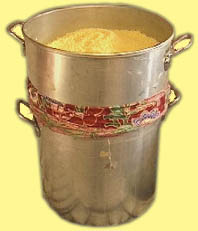
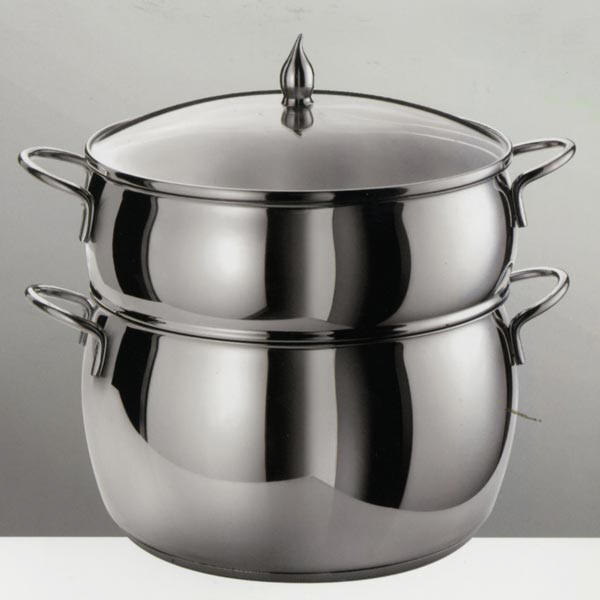
The Recipe: "Trapani-style fish couscous"
Ingredients for 4 people)
- 500 of coarse-grained semolina (or 250 coarse-grained and 250 fine-grained) if you want to use the traditional process.
- 250 gr. of pre-cooked couscous in case you want to use the simplified method.
- 1 kg. among fish, molluscs, crustaceans and seafood (snapper, sea bream, grouper, mullet, cuttlefish, clams, mussels, shrimps)
- 500 gr. of ripe tomatoes
- 2 cloves of garlic
- 2 stalks of celery
- 2 carrots
- 1 onion
- 1 sprig of parsley and 1 bay leaf
- 1 saffron
- 1 pinch of paprika
- salt and pepper to taste
- extra virgin olive oil
- chili pepper to taste
- a knob of butter (simplified procedure)
- Options:
- 50-60 g of chopped almonds
Traditional procedure.
1) Prepare the couscous according to the traditional method previously described (500 g. Of semolina).
2) Prepare the fish and seasonings
Clean the fish, bone them, remove the shells from the crustaceans and the shells from the seafood. Put the fish bones and heads, as well as the crustacean shells in a pan, cover with water flavored with half an onion, a few parsley leaves, carrots and celery, season with salt and pepper; cook for a good half hour, filter the broth and set it aside.
In a saucepan, brown the other half of the onion in oil with the carrot, celery, chopped parsley, as well as the whole garlic, which will be removed as soon as it is golden brown, the saffron, paprika and chilli.
First add the fish that require longer cooking time, then the shellfish. Sprinkle with half of the broth filtered and kept aside, add the tomato pulp and cook for a quarter of an hour.
Add the seafood, season with salt, continue cooking for about ten minutes, and then keep warm.
3) Cook the couscous with the couscous pot
In the lower part of the couscous bowl put the filtered and elongated broth, in the upper part the couscous to which olive oil has been added. Drill 4 or 5 holes, they will facilitate the exit of the steam from the cusscussiera. Cover with the lid and turn on the fire. As soon as the steam comes out of the holes made in the couscous, lower the heat, put the lid on so that an open space remains and cook for about two and a half hours. At this stage, you need to mix the couscous every now and then (10-15 minutes) and possibly make new holes. In the last part of cooking, stir a little more often, repeating the procedure until cooking is complete.
In the absence of the "couscoussiera" you can use a steam cooking basket to be placed in a pot or saucepan with a lid, making sure it has a good seal.
Pour the steamed couscous into a tureen, add the other part of broth and season with the ready-made and warmed fish.
Simplified procedure.
1) Prepare the fish and seasonings as indicated in the traditional procedure
2) Cook the precooked couscous in a saucepan
Bring part of the prepared broth to a boil (about 250 ml) by adding 3-4 tablespoons of oil. Remove from the heat and add the couscous grains, stirring gently with a fork and let them absorb the broth (the grains will swell). Then add the butter and cook again, over medium heat, for three to four minutes, stirring constantly.
Wet the couscous with part of the liquid from the fish and arrange on serving plates, then season with the fish. Serve more hot broth in a gravy boat so that the diner can use it at will.
variants
Couscous can be fish, meat or prepared only with vegetables. In some cases, different ingredients are provided such as the addition of ground almonds.
Some videos from the Net
Technical data sheet of the traditional agri-food product (PAT)
Not available
Source Pat Cards: Sicily Region
Card insertion: Ignazio Caloggero
Information contributions: Web, Region of Sicily
Note: The population of the cards of the Heritage database proceeds in incremental phases: cataloging, georeferencing, insertion of information and images. The cultural property in question has been cataloged, and the first information has been entered. In order to enrich the information content, further contributions are welcome, if you wish you can contribute through our area "Your Contributions"



